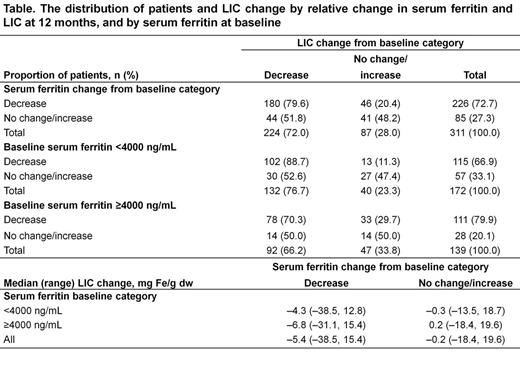Abstract

Background
Serum ferritin is regularly used to assess response to chelation therapy and correlates significantly with liver iron concentration (LIC) particularly when LIC is <7 mg Fe/g dry weight (dw) and serum ferritin is <4000 ng/mL. The absence of a serum ferritin decrease in the first months of a new chelation regime may be interpreted as a lack of response with respect to decreasing body iron load. However, sequential LIC determination (where available) has indicated that many of these patients do indeed have a decrease in LIC. This clinical experience requires greater understanding, particularly the nature of the LIC and serum ferritin relationship at baseline serum ferritin values ≥4000 ng/mL.
The aim of this post-hoc analysis of the EPIC study was to gain insight into the relationship between serum ferritin and LIC in response to deferasirox over 1 year, in a large patient cohort, so that serum ferritin trends can be more clearly interpreted and evidence-based practical guidance be given for patients with transfusion-dependent thalassemia (TDT).
Methods
TDT patients were recruited from 25 sites, received 1-year of deferasirox treatment and had serum ferritin and R2 magnetic resonance imaging (R2-MRI)-assessed LIC measurements at baseline and 1 year. Summary statistics are provided for serum ferritin and LIC responders (decrease, any change from baseline <0) and nonresponders (increase or no change, any change from baseline ≥0), and for baseline serum ferritin categories (≥4000 vs <4000 ng/mL).
Results
Of the 374 patients analyzed in the EPIC liver MRI substudy, 317 had TDT, of which 72.7% (n=226) had a serum ferritin response and 27.3% (n=85) had no response. Importantly, after 1 year LIC decreased in approximately half of serum ferritin nonresponders (51.8%; n=44; Table) and in 79.6% of serum ferritin responders (n=180). Median (min, Q1, Q3, max) change in LIC (mg Fe/g dw) was –5.4 (–38.5, –11.7, –0.9, 15.4) in serum ferritin responders and –0.2 (–18.4, –2.6, 2.7, 19.6) in nonresponders. Median (range) transfusional iron intake (mg/kg/day) was similar in serum ferritin responders (0.30 [0.01–1.49]) and nonresponders (0.37 [0.02–1.00]). Median deferasirox dose (mg/kg/day) was higher in serum ferritin responders than nonresponders (28.1 [9.8–40.4] vs 23.7 [9.7–37.9]).
Evaluation of responses by baseline serum ferritin showed that a greater proportion of serum ferritin responders with baseline serum ferritin <4000 ng/mL also had decreased LIC (88.7% [n=102]; Table), compared with serum ferritin responders with baseline serum ferritin ≥4000 ng/mL (70.3% [n=78]). However, serum ferritin baseline category had no effect on the proportion of patients who decreased LIC despite having no serum ferritin response (52.6% [n=30], <4000 ng/mL; 50.0% [n=14], ≥4000 ng/mL; Table). There was little change in median LIC in serum ferritin nonresponders after 1 year regardless of baseline serum ferritin value (–0.3 [–13.5–18.7] for <4000 ng/mL and 0.2 [–18.4–19.6] for ≥4000 ng/mL).
Assessment by change in serum ferritin and LIC quadrants indicated that patients without serum ferritin or LIC response had the lowest baseline median (range) serum ferritin and LIC (2155 [480–9725] ng/mL; 11.9 [1.8–37.5] mg Fe/g dw; n=41), and received a lower median deferasirox dose (23.7 [9.7–36.0] mg/kg/day). Overall, median LIC decrease (mg Fe/g dw) was smaller in patients with baseline serum ferritin <4000 ng/mL (n=172) than in those with serum ferritin ≥4000 ng/mL (–2.8 [–38.5–18.7] vs –4.9 [–31.1–19.6]; n=139). Median iron intake was similar between groups.
Discussion and conclusions
A decrease in LIC was seen in ~80% of serum ferritin responders after 1 year of deferasirox; a greater proportion of serum ferritin responders (88%) decreased LIC when baseline serum ferritin was <4000 ng/mL. Importantly, among patients with no serum ferritin response up to half may be responding with respect to iron balance, indicating that a lack of serum ferritin response should be interpreted with caution. However, since a decrease in serum ferritin predicts a decrease in LIC in 80% of patients, MRI measurement (where available) should be prioritized for patients with serum ferritin increase/no change. Overall, serum ferritin response can help predict LIC response, but in some patients treated with deferasirox, serum ferritin may not accurately reflect removal of iron from the body.
Porter:Novartis: Consultancy, Honoraria, Research Funding; Shire: Consultancy, Honoraria; Celgene: Consultancy; Cerus: Membership on an entity's Board of Directors or advisory committees; Alnylam: Membership on an entity's Board of Directors or advisory committees. Taher:Novartis: Honoraria, Research Funding. Sutcharitchan:Novartis: Research Funding. Aydinok:Novartis: Membership on an entity's Board of Directors or advisory committees, Research Funding, Speakers Bureau. Chakravarty:Novartis: Employment. El-Ali:Novartis: Employment.
Author notes
Asterisk with author names denotes non-ASH members.

This icon denotes a clinically relevant abstract


This feature is available to Subscribers Only
Sign In or Create an Account Close Modal